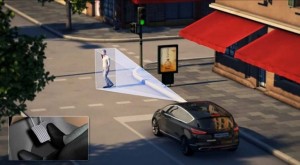Automatic Emergency Braking will become standard on virtually all cars sold in the United States by 2022, a group of leading automakers, safety advocates and regulators will announce today, according to several sources.
The development is the result of an unusual consortium formed last autumn that is expected to serve as precedent for other efforts to get advanced safety technology into new vehicles faster than would be possible through the traditional legislative process.
Emergency Auto Braking, also known as Automatic Emergency Braking, can detect when a vehicle is at risk of getting into a front-end collision and slow it or even bring it to a full stop. A recent study by the Insurance Institute for Highway Safety, or IIHS, found that it can reduce such collisions by as much as 40%.
(Autonomous driving advocates tell Congress to create new rules. Click Here for the story.)
While Mark Rosekind, the director of the National Highway Traffic Safety Administration wouldn’t confirm the announcement, he signaled the government’s goal of encouraging the use of advanced technology – up to and including fully autonomous vehicles – during an appearance at a conference on self-driving technology in Detroit.
“We need a higher bar if we’re going to get to zero,” he said, referring to a goal of having zero fatalities on U.S. highways. “Safety technology offers us that opportunity.”

US Transportation Sec. Anthony Foxx is shown surrounded by industry leaders during a visit to Detroit.
Highway fatalities have plunged about 40% since peaking in the 1970s, despite having more cars on the road driving significantly more miles. The death total fell to 32,675 in 2014, though it did take an unusual rise of about 8% last year, NHTSA has estimated. Distracted driving – including texting behind the wheel – is considered one reason behind that rise.
New technologies have already contributed to the decades-long downturn. That includes passive safety systems, such as airbags, designed to help an occupant survive a crash; and newer active safety technology. The IIHS and NHTSA have suggested that electronic stability control has been one of the most important breakthroughs in recent years, but even more advanced systems are starting to roll out onto the market.
(Ford, GM betting big on autonomous tech, mobility services. Click Here for more.)
That includes such things as blind spot detection and lane departure warning, all the way up to semi- and fully autonomous vehicles. But the next widespread move is now expected to be the adoption of emergency auto braking.
The technology uses radar, cameras or both to scan the road ahead of a vehicle. If the system detects a potential problem it will sound a warning to alert the driver to brake. If there is no reaction, the system will apply the brakes automatically. In many cases, that is enough to prevent a crash or at least reduce the severity of the impact.
Auto braking, or a less advanced technology called forward collision warning, have already become available on a number of vehicles, especially those in the luxury segment. But NHTSA has wanted to see such features become standard – and to do so more quickly than would be possible through the slow and laborious regulatory process.
The consortium was formed last autumn by 10 automakers who agreed to work together – possibly even to the point of sharing intellectual property – with safety advocates and regulators. Sources say the group now includes 20 major manufacturers, including General Motors, Ford, Toyota, Daimler AG and others from the U.S., Asia and Europe.
The announcement comes a bit later than original expected. In January, NHTSA Administrator Rosekind signaled the adoption of auto braking would come by the end of the month.
One reason, according to insiders, was pressure from some industry critics, such as former NHTSA boss Joan Claybrook, a safety advocate who felt the approach initially being developed wouldn’t go far enough.
The formation of the auto brake consortium set the stage for an even more ambitious project announced by Transportation Secretary Anthony Foxx in January during a visit to Detroit. Another consortium has been formed to promote the adoption of additional safety technology faster than would be possible through regulatory action.
“Perhaps years from now,” Foxx said at the time, “we will look back at this moment as a moment when, at a time when there may have been some skepticism about the safety of the automotive industry, in general, the industry stepped up and made a hard pivot with us towards a proactive culture.”
(For more on the expanded auto safety consortium, Click Here.)


